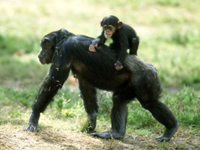

 |

|
 Chimpanzee |
Chimpanzee(Mammal) |
 Chimpanzee Baby |
Chimpanzee HabitsThe chimpanzee lives in a troop that numbers between 25 and 80. Each troop has a dominant male. The troop's home range varies in size from 7-8 square miles in the forest to 40-75 square miles in the open country.
Active by day, the chimpanzee sleeps at night in a nest it makes in a tree, well above ground, safe from its predators. The same nest may be used for several nights if the troop is not on the move.
Chimps stay mainly in trees during the wet season and on the ground whit it is dry. |
Chimpanzee CommunicationChimpanzees communicate using facial gestures, loud sounds, and sign language. They have large brains and are extremely smart. When they warn each other or fight, they usually scream or make loud noises. They also give out loud hoots when they are fighting or when arguing over little food. When they are scared, their lips move and they start screaming. When they are relaxed their face is very calm. A chimps full open grin means that he or she is scared or very excited.
Chimps have senses that are like people. They also communicate without using symbolic communication. Each chimp has their own hoot, so the other chimp can be identified. All zookeepers know this. When a chimpanzee gets attacked, they usually start screaming to tell the attacker that if you come closer, you will get hurt. Chimps are always good at seeing the behavior of others. Chimps can learn sign language. |
Chimpanzee BreedingBreeding takes place year-round. When one of the females in the group comes into season, or heat, she will mate with several different males. The males show no sign of competition between themselves. Females have menstrual cycles much like humans and come into estrus every 36 days unless they are pregnant. They give birth about every three years after a gestation period of seven to eight months.
The young chimp is carried everywhere for its first five months and is dependent on its mother for two years. By the time the youngster is four years old, it spends most of its time with other chimpanzees close to its own age. It reaches sexual maturity at eight to ten years. |
Chimpanzee Food & FeedingFruits of all kinds make up the majority of the chimpanzee's diet. It will also eat insects such as termites and ants, the larvae of several insects, and honey. It gets most of the water it needs from fruit.
It was only recently discovered that the chimpanzee eats meta. It is now known that it hunts, kills, and feeds on a variety of mammals, including other primates such as colobus monkeys, blue monkeys, and baboons.
The killing is almost always done by one adult male who smashes the animal's head on the ground. The male eats his fill before sharing with the troop. |
Chimpanzee Key Facts |
| Size |
| Height: Males, 5 1/2 feet; females 4 1/4 feet |
| Weight: 100-175 pounds |
| Breeding |
| Sexual maturity: 8-10 years |
| Mating: Female mates when previous offsping is about 3 years old |
| Gestation: 202-261 days |
| Number of young: 1-2 |
| Lifestyle |
| Habit: Sociable, in small troops |
| Diet: Mainly fruit, but also leaves, buds, blossoms, bark, resin, honey, termites, and ants. Occasionally other mammals |
| Lifespan: 40-50 years |
DID YOU KNOW?
|
CAN'T FIND WHAT YOU'RE LOOKING FOR? CLICK HERE!!!